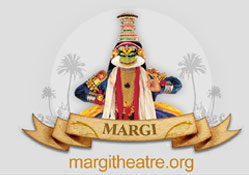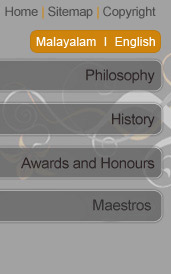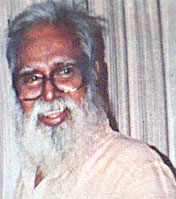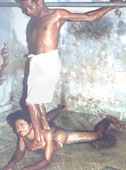 |

Margi's philosophy as regards the two essential theatre arts of Kerala viz Kathakali and Koodiyattom had been envisioned by theatre legend D.Appukuttan Nair, one of its founders. |
 |
Late D.Appukkuttan Nair , the prime mover behind Margi and a noted author of several Attaprakarams(Choreography) articles and books on Kathakali, architect of 'Koothambalams' at Kerala Kalamandalam and Kala Kshetra, Chennai and a noted Civil Engineer as well. |
Institutional training was started for Kathakali for the first time in the 1930's and for Koodiyattom in the sixties. This was to ensure training of artistes in larger numbers and in a more regulated basis. But it had several shortcomings such as the fact that the artistes had to leave the institution at the end of their training and could not find openings to continue in the profession. Most of them had to pursue unrelated professions for a living. More importantly the system was not conducive to leading to the highest level of personal excellence and creativity which the 'Kaliyogam' system of earlier times ensured. Under the ‘Kaliyogam’system, the unit is a performing group staying together all the time. The Chief Guru is always a senior and well accepted master of the art form. A Kathakali play may require as many as 30 artistes (actors, drummers, singers make-up and stage hands, all included). The artistes will be graded according to the complexity and type of the roles they excel in. New artistes are taken at a very tender age (say 10 years) and trained continuously; in basics, smaller roles, senior roles; in that order (‘Kuttitharam’, ‘Idatharam’,‘Adyavasana’) as dictated by aesthetic considerations only. Training is perpetual at all levels. The seniors continuously hone their skills by acting in new productions / poetic elaboration of existing plays or sections thereof. The training period is during the rainy season (June to September) and mostly goes hand in hand with body massage (known as Uzhichil) which is important for all levels. |
 |
A key function of a Kaliyogam is to have variety in its repertoire so as to sustain interest in the art. Kathakali aficionados are a fastidious lot and it is they who fuel the artiste’s aspirations to reach ever higher aesthetic levels; an unending quest. Building up a repertoire with variety is a very hard task demanding multi-disciplinary skills involving the artistes, singers, percussionists, make-up and stage hands. Learning of texts, evolving choreographic details, rehearsing and fine tuning and stage presentation in the end, are all parts of the process. The Margi Kaliyogam in Kathakali and Koodiyattom has evolved on the above lines. Highly structured and sophisticated arts like Kathakali and Koodiyattom in particular, will remain esoteric only. Undue concern for general popularity and tailoring of the arts to this object are known to have proved counter productive. On the other hand, to ensure the continued existence of an interested and knowledgeable audience, a must for the development of any art, it is necessary to impart some training in the art appreciation to those interested. Wider audience reach is opening up in the form of the ever expanding print & visual media. By audience education, enlightenment & involvement via the visual media in particular, the audience base can be substantially widened. In fact, this is actually happening as evidenced by the ever larger numbers which Kathakali & Koodiyattom shows are drawing in recent times. Philip B. Zarrilis books surveys the Kathakali scenario in Kerala in great detail, depth & insight. This will be of immense interest in this context. |
